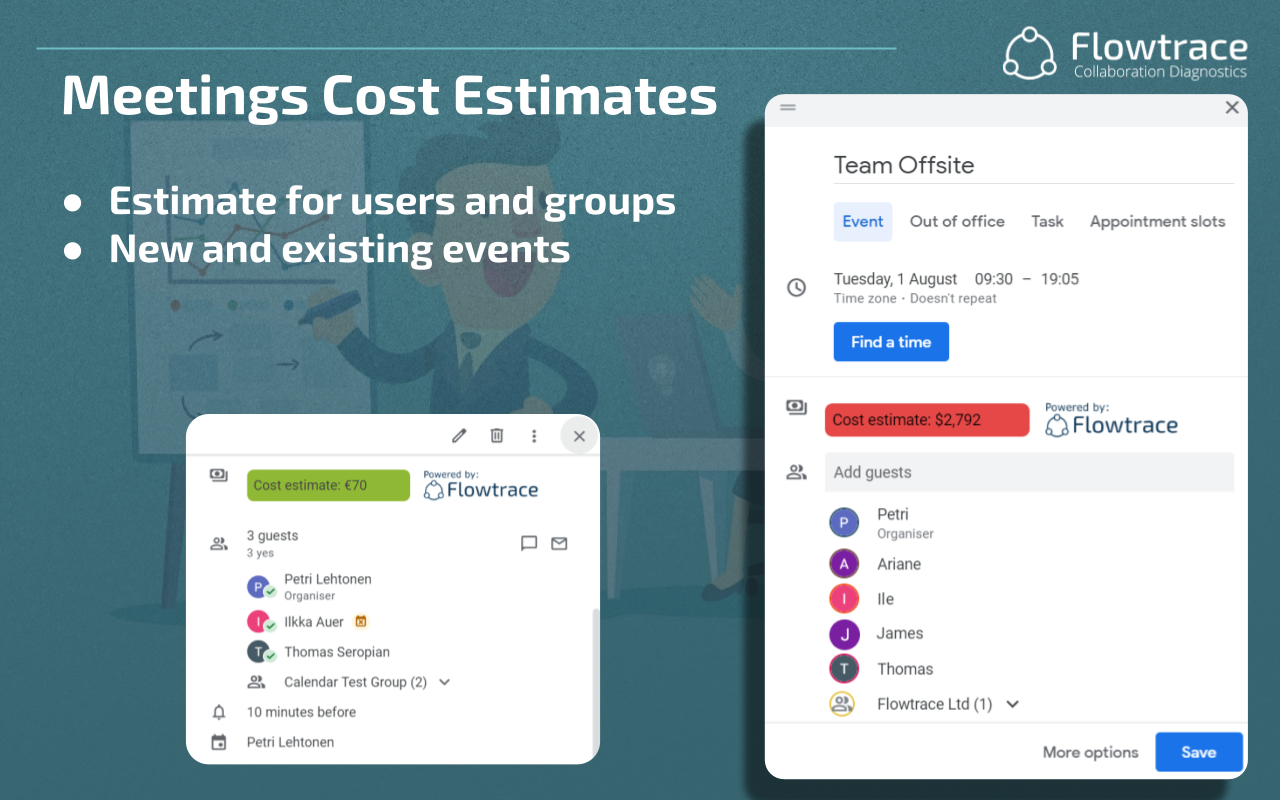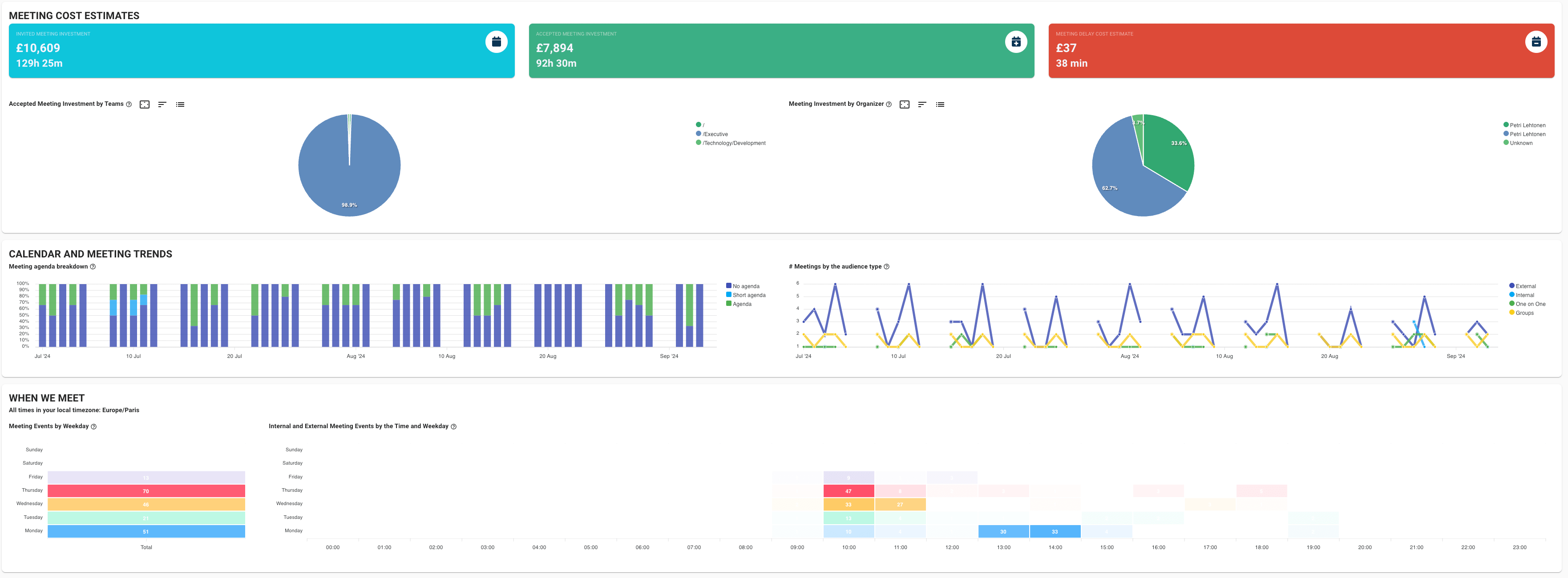Building a Meeting Culture With Analytics
Transform your meeting culture with analytics to boost productivity and efficiency. Learn how data-driven practices can optimize meetings and align...
Discover how analytics can revolutionize meeting productivity by optimizing schedules, enhancing engagement, and driving strategic decision-making within organizations.
Analytics offers a new approach to meeting productivity enabling businesses to scrutinize every aspect of meeting practices, from duration and frequency to cost and planning. These data-driven insights allow companies to turn routine meetings into strategic, productive sessions that genuinely contribute to organizational goals. As we delve deeper into the impact of analytics on meeting productivity, it's clear that the ability to utilize this information is changing the way we look at meetings, making them more efficient and aligned with broader business objectives.
Meeting analytics comprehensively examines the components of meetings to optimize effectiveness and efficiency within an organization. This involves analyzing metrics such as attendance, punctuality, duration, costs, and the achievement of defined objectives. Each of these data points provides crucial insights that can inform better meeting management strategies.

A study from Harvard Business Review noted that executives believe only around 17% of meetings are productive uses of group and individual time. Further, analytics have shown that reducing meeting frequency can significantly increase dedicated work time, thereby enhancing overall productivity.
With detailed meeting analytics, organizations can identify not just how many meetings occur, but their nature and necessity. For example, analytics might reveal that multiple team updates throughout the week could be consolidated into a single, more efficient session, or that decision-making meetings are more productive with fewer participants. Insights like these are invaluable for reshaping meeting cultures to be more respectful of employees' time and more conducive to productivity.
Analytics play a key role in enhancing meeting efficiency by identifying trends and patterns that may not be evident without a deep dive into meeting data. By systematically analyzing meeting attributes over time, organizations can detect inefficiencies and areas for improvement. For instance, analytics might reveal that certain meetings consistently start late or run over the allotted time, suggesting a need for better time management or agenda setting.




With detailed analytics, organizations can refine their meeting schedules to better align with actual needs and employee availability. For example, analytics might show that mid-morning meetings have higher participation and energy levels compared to late-afternoon sessions. Organizations can use this insight to schedule critical strategic meetings at optimal times, thereby maximizing effectiveness and engagement.

A revealing statistic from the Harvard Business Review shows that up to 71% of senior managers view their companies' meetings as unproductive and inefficient. This significant figure highlights the potential for analytics to transform meeting practices by providing evidence-based insights that challenge the status quo.
By integrating these metrics and insights, organizations can systematically enhance the planning, execution, and outcomes of their meetings, leading to a more focused and productive use of time. This not only boosts overall productivity but also enhances employee satisfaction by reducing unnecessary meeting burdens.
Analytics can significantly enhance decision-making processes related to meeting management by providing objective data that informs better practices. By analyzing meeting-related data, organizations can make informed decisions on various aspects of their meeting culture, from scheduling to participant selection.
Effective meeting management often begins with strategic scheduling. Analytics provide insights into the best times for meetings, considering participant availability and historical data on meeting effectiveness at different times of the day or week. This allows organizations to schedule meetings when they are most likely to be productive, ensuring that time allocated for meetings is used efficiently.
Analytics can also guide decisions on who should attend meetings. By examining participation rates and the impact of different attendees on meeting outcomes, organizations can identify key contributors whose presence is essential, as well as participants who may not need to attend every meeting.

This targeted approach not only makes meetings more focused and directive but also respects the time of all employees, allowing them to devote more effort to their primary job responsibilities.
Different meeting formats can serve different purposes more effectively. For instance, strategic planning might be best done in longer, in-depth sessions, while updates can occur in brief stand-up meetings. Analytics help identify which formats work best for specific types of meetings by analyzing past meeting data, such as engagement levels and achievement of objectives. This enables organizations to adapt their meeting formats to match the intended purpose, leading to more effective and efficient gatherings.
By integrating analytical insights into meeting management, organizations can craft a more productive meeting environment that not only achieves specific meeting goals but also aligns with broader organizational objectives. This strategic use of data empowers teams to hold meetings that are both necessary and optimally structured, enhancing overall workplace productivity and satisfaction.
Effective meeting management often requires overcoming several common challenges, including over-scheduling, a lack of focus, and unengaged participants. These issues can significantly detract from the productivity of meetings, turning them into a source of frustration rather than a useful tool for collaboration and decision-making.
Over-scheduling is a frequent problem in many organizations, where back-to-back meetings can dominate calendars, leaving little time for actual work. Analytics can address this issue by providing data on the total number of meetings, their duration, and their perceived necessity.

By analyzing trends and patterns, organizations can identify and eliminate redundant or non-essential meetings, freeing up valuable time for employees.
A lack of focus during meetings can often be attributed to unclear agendas or objectives. Analytics can help by tracking the alignment of meeting outcomes with their stated goals. By reviewing data on meeting effectiveness, organizations can start to enforce stricter agenda settings and ensure that each meeting has a clear purpose. This not only sharpens the focus of discussions but also makes it easier to measure the success of each session.
Unengaged participants can undermine the effectiveness of meetings, often leading to poor outcomes. Analytics can play a crucial role by monitoring participant engagement levels, which can be measured by contributions to discussions, feedback provided, and follow-through on action items. Insights from this data can help meeting organizers to adjust their strategies, perhaps by involving more interactive elements, reducing meeting length, or altering the format to better maintain attention and participation.
The strength of analytics lies in its ability to provide evidence-based insights that guide improvements. For example, if data shows that meetings later in the day tend to have lower engagement rates, companies might consider scheduling important discussions in the morning. Similarly, if analytics reveal that smaller meetings tend to be more productive, organizations might opt to limit the number of participants for certain types of meetings.
By systematically using analytics to identify and address these common meeting challenges, organizations can enhance the overall productivity and effectiveness of their meetings. This approach not only makes meetings more valuable but also contributes to a healthier, more dynamic workplace culture.
Flowtrace provides detailed analytics to significantly enhance the effectiveness of meetings within organizations. By collecting and analyzing data on various aspects of meetings, such tools help identify inefficiencies and areas for improvement in real time. This includes tracking time spent in meetings, days of meetings, those with an agenda, and more.

One of the key advantages of using analytics in meeting management is the ability to make real-time adjustments. For instance, if analytics indicate that engagement drops significantly after the first 30 minutes, organizations can start to structure meetings to be shorter, more focused, or perhaps include scheduled breaks to maintain concentration. Similarly, if certain types of meetings consistently fail to start on time, prompting features can be implemented to remind participants to prepare and join on time.
Analytics also provide a proactive approach to managing meeting quality. By continuously gathering data on the outcomes of meetings, such as whether the goals were achieved and how satisfied participants were with the proceedings, these platforms can help organizations refine their meeting strategies. This might involve adjusting the frequency of meetings, reshaping the agenda structure, or even reevaluating who needs to be involved in certain discussions to optimize productivity.
By leveraging tools like Flowtrace, organizations can transform the often undervalued meeting time into a productive asset that drives real business outcomes. This is crucial for not only spotting and correcting inefficiencies but also for fostering an environment where every meeting is an opportunity to collaborate effectively and make decisions that propel the organization forward. Such capabilities make analytics an indispensable part of modern meeting management, helping to tune the dynamics of meetings to the rhythms of organizational productivity in real-time.
The use of analytics in meeting management not only leads to better utilization of organizational resources but also boosts overall employee satisfaction. Employees benefit from a culture that values their time and contributions, reducing unnecessary meeting fatigue and fostering a more engaging and productive work environment. Organizations that adopt analytic approaches to revamp their meeting cultures can expect to see substantial improvements in collaboration and decision-making effectiveness.
Transform your meeting culture with analytics to boost productivity and efficiency. Learn how data-driven practices can optimize meetings and align...
Enhance productivity and optimize time management with calendar analytics for Microsoft Outlook. Access valuable insights and tools for efficient...
Transform your organization with data-driven meeting cultures. Learn how to optimize meetings, increase productivity, and drive better business...